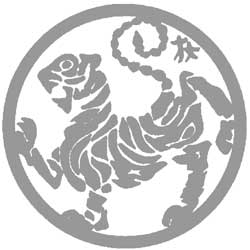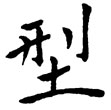
Japan Karate Association of Wisconsin

"one meeting, one opportunity"
< back |
||
 |
||
|
kata
|
||
The kata practiced at JKA Wisconsin
Kata is the very essence and foundation of Shotokan Karate. It is the encyclopedia of the system and through it the knowledge of the art form is passed down from generation to generation. Kata teaches the body stances, dynamic movements, and the principles of generating power from the hips and body. Also, kata teaches proper use of breath, timing, distance, rhythm and coordination, and the fighting spirit and mindset of the art. Three essential elements should always be considered in each movement of any kata. These three elements are: application of power (i.e. strength or gentleness of power), speed of technique (i.e. slowness or quickness of technique), and extension and contraction of body (i.e. compression of body or expansion of body).
Also important in the study of kata is 1) executing exactly the correct number and type of techniques, 2) executing the techniques in the correct order, 3) executing the techniques with the correct timing in relationship to one another, and 4) adhering to the correct direction/position and kata pattern (i.e., enbusen).
Kihon in Kata
First, a word about Kihon. Kihon means basics, or fundamentals. If kata is the heart of the Shotokan karate system, then the kihon is the blood and the foundation of the kata. All kata are designed to build strong basics and prepare students for the more advanced aspects of Karate.
The Five Heian Kata
Said to have been created by Funakoshi's teacher Itosu Yatsume, these kata were developed to further help in teaching basic techniques and to help in conditioning the body, and learning proper hip usage. The name Heian comes from the contraction of the characters for heiwa and antei, meaning peace and stability. Many other karate systems, including Shito-ryu, use the Pinan kata series which is a slight variation of the Heian, the name Pinan meaning the same.
Heian Shodan (Peaceful Mind First or #1)
Emphasis on basic low blocks/strikes and stepping punch, moving
through the center and building strong and low front stances, hammer
fist technique and face blocks/strikes, including transitionally
timed blocks and strikes, back stance knife hand block/strike, proper
basic breathing and application of kiai. Hip rotation, vibration,
shifting/thrusting, reconnection.
Heian Nidan (Peaceful Mind Second or #2)
Emphasis on multiple blocks, trapping/breaking techniques, back
stance knife hand block/strike, reverse stance blocks and counters,
transitional blocks and counters, proper basic breathing and application
of kiai. Hip rotation, vibration, shifting/thrusting, pendulum (side
snap kick), and reconnection.
Heian Sandan (Peaceful Mind Third or #3)
Emphasis on multiple blocks, trapping/breaking techniques, release
from wrist locks and grabs, forearm deflection and back fist strikes,
defense from various grabs and holds, proper basic breathing and
application of kiai. Hip rotation, vibration, shifting/thrusting,
reconnection.
Heian Yondan (Peaceful Mind Fourth or #4)
Emphasis on multiple blocks, trapping/breaking techniques, kicking
and countering, double arm block/break/release, devastating counter
attacks with elbow and knees, front kick defense, defense from various
grabs and holds, proper basic breathing and application of kiai.
Hip rotation, vibration, shifting/thrusting, pendulum (side snap
kick and front kick), reconnection.
Heian Godan (Peaceful Mind Fifth or #5)
Emphasis on multiple blocks, trapping/breaking techniques, defense
from various grabs and holds, Leg blocks and strikes, continuous
changing of focus and direction of attacker, take downs, proper
breathing and application of kiai. Hip rotation, vibration, shifting/thrusting,
pendulum (side snap kick and front kick), reconnection, up and down
energy.
Included here are the original JKA training videos of each of the Heian kata. They are in MPEG format and viewable on both Mac and Windows computers. They are meant only as a supplemental resource to your dojo training and it should be noted that in many cases the JKA Wisconsin dojo teaches variations that are different from what is demonstrated in these particular videos.
The Three Tekki Kata
The Tekki kata originated in China. Know originally in Okinawa as naihanchi, the Tekki kata were renamed Tekki by Mr. Funakoshi. The characters for Tekki mean iron and horseman, or "mounted on horseback." The "horse-riding" stance, or kiba dachi, is emphasized exclusively in these kata.
Tekki Shodan (Horse Riding First or #1, also called Naihanchi)
Very old Shuri-te kata, Straddle-leg stance. Hip vibration and rotation.
Tekki Nidan (Horse Riding Second or #2)
Modeled after Tekki #1 created by Itosu. Grasping and hooking blocks.
Hip vibration and rotation.
Tekki Sandan (Horse Riding #3)
Modeled after Tekki #1 created by Itosu. Grasping and hooking blocks,
continuous middle level blocking and grappling and breaking. Hip
vibration and rotation.
Included here are the original JKA training videos of each of the three Tekki kata. They are in MPEG format and viewable on both Mac and Windows computers. They are meant only as a supplemental resource to your dojo training and it should be noted that in many cases the JKA Wisconsin dojo teaches variations that are different than what is demonstrated in these particular videos.
The Advanced Kata of Shotokan Karate
Included here are the original JKA training videos of each of the advanced kata of Shotokan Karate. They are in MPEG format and viewable on both Mac and Windows computers. They are meant only as a supplemental resource to your dojo training and it should be noted that in many cases the JKA Wisconsin dojo teaches variations that are different than what is demonstrated in these particular videos.
Bassai Dai ("Penetrating the Fortress" - Greater)
This is one of the oldest kata in the system and is common, in many
variations of both technique and name, to different styles of Japanese
karate. This kata is known for its application of power and strength
and changing disadvantage to advantage by the use of switching strikes
to blocks and blocks to strikes. Extreme use of hip rotation is
a hallmark of this kata, although all of the major hip actions can
be found throughout it. This is a Shuri-te school kata of Itosu.
There are two forms of Bassai taught in the Shotokan syllabus: Bassai-Dai
and Bassai-Sho. Bassai-Dai is considered one of the most important
kata for shodan first- and second-degree black belt level, along with Jion, Empi and Kanku-Dai.
Jion (Named for Jion Temple in China, a Buddhist term meaning love and/or goodness)
One unique feature of this kata is the hand position that both starts
and ends the kata. This position is a slight variation on a Chinese
hand salutation or greeting. One interpretation is of the warrior's spirit cloaked in or mastered by peace. This basic but powerful kata is considered
one of the best representative kata of the Shotokan system. Although
the kata is composed of primarily basic stances and techniques,
it is quite difficult to perform properly. There is little room
for error and nowhere to hide or mask poor technique.
Enpi/Empi ("Flying Swallow")
The use of the "n" or "m" in spelling this kata
is a matter of debate, although the most correct phonetic translation
requires the use of an "n" in its name.
Named "Flying Swallow" because of its sharp and quick
rising and descending movements and its trademark jump. A very advanced kata
with detailed and devastating applications.
Kanku Dai ("Watching the Sky" - Greater)
Originally named Kusanku, Itosu used the movements and sequences
of this important kata to create the Five Heian kata. Considered
the one of the "big four" of the Shotokan System for
black belt level (along with Jion, Empi and Bassai-Dai) it was said to
have been the favorite of Mr. Funakoshi.
Hangetsu ("Half Moon")
Taken from the kata Seishan of the Okinawan System, this kata's
name refers to the distinctive stance combining inward rotation of the legs with pressure to the floor through the center and movements of the foot also through the center. Also important is the emphasis on distinctive breathing
techniques reminiscent of Okinawan Tensho and Sanchin kata.
Gankaku ("Crane on a Rock")
Jitte ("Ten Hands")
Bassai Sho ("Penetrating the Fortress" - Lesser)
Kanku Sho ("Watching the Sky" - Lesser)
Nijushiho ("Twenty-four Steps")
Sochin ("Strength"/"Calm")
Meikyo ("Bright Mirror")
Ji'in ("Temple Grounds", or "Love")
Wankan ("King's Crown")
Chinte ("Curious Hands", "Rare Hands", or "Unusual Hands")
Gojushiho Sho ("Fifty-four Steps" - Lesser)
Gojushiho
Dai ("Fifty-four Steps" - Greater)
Features neko-ashi-dachi, or cat stance, another stance dependent on internal rotation of the legs and pressure through the center. Gojushiho Dai primarily relies on mastery of ippon nukite, or single-finger strikes, with complimentary reliance on hooking blocks with the base of the thumb. A huge challenge to stance stability and mobility, especially featuring the hooking foot sweep with the heel that neko-ashi-dachi allows.
Unsu ("Hands in the Clouds", or "Cloud Hands")
The most advanced kata in Shotokan karate, featuring rapid changes of direction, fighting from the floor and in almost every stance.
